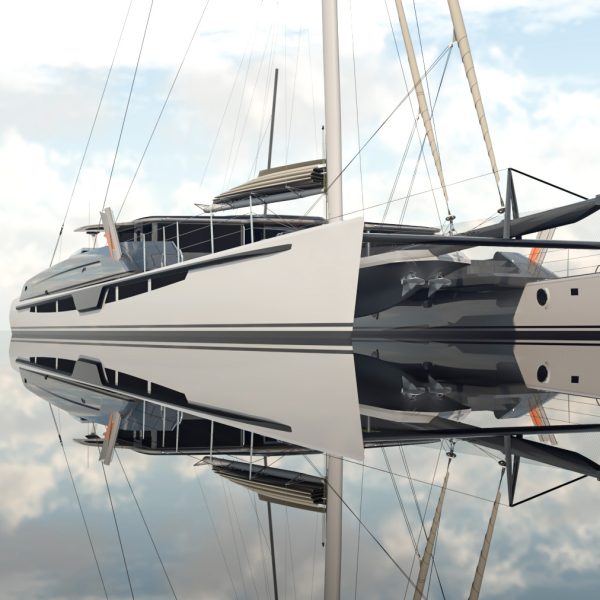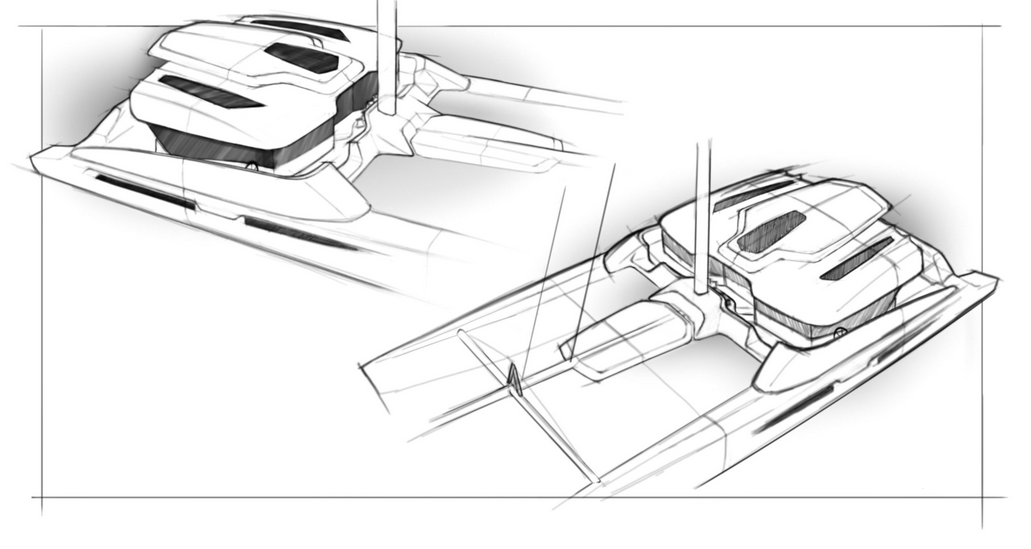
Bellevue Eco
Catamaran
Welcome to our site where you can find out more about the vision of the Bellevue ECO catamaran! Immerse yourself in the history, specifications and progress of the project. Here you can learn all about the innovative design, the sustainable construction method and receive weekly updates on our journey.
History of the catamaran
The maxi-catamaran “Gemini-3” (formerly “Bioton®”) was designed and built in 2007 by the renowned Marstrom Composite shipyard in Sweden, under the direct supervision of Captain Roman Paszke. High-quality carbon pre-preg/Nomex composites were used in the construction of the two hulls of this avant-garde yacht.
During the manufacturing process, models of the floats were created using a high-precision 5-axis CNC milling machine. These models served as the basis for the molds in which the float elements were laminated using a vacuum process in special autoclaves. This innovative construction method ensures a highly resilient and lightweight design.

Roman Paszkes Sailing around the world
Roman Paszke, experienced captain of sailing yachts, is characterized by his impressive career in regatta sailing, nautical science and yacht construction. As a multiple Polish champion and successful participant in international regattas, he has earned an outstanding reputation. His command of the yacht Warta-Polpharma in the demanding round-the-world regatta “The Race” is particularly noteworthy. As the initiator of the Polish Race 2000 program, he finished in an impressive fourth place in 2001, after 99 days and 32,000 nautical miles. With over 40 years of ocean sailing experience, more than 90,000 nautical miles and a solo Atlantic crossing between Cadiz and New York, Captain Paszke has an impressive sporting repertoire.



In 2007, he planned the solo circumnavigation of the world in an east-west direction with the yacht “Bioton”, later “Gemini-3”. Adverse weather conditions forced him to cancel the circumnavigation. In December 2011, Paszke set off on a circumnavigation from east to west, but a yacht breakdown in January 2012 led to the temporary grounding of the “Gemini-3” in Argentina until the legal dispute was settled in mid-June.
On December 27, 2012, Roman Paszke once again started his attempt to sail solo and non-stop around the world against the wind. The starting point was Las Palmas on the Canary Islands. Unfortunately, a rudder failure forced him to turn back six hours later. Another start took place on January 7 at 19:14 CET from Gran Canaria with his catamaran “Gemini 3”.
The aim was to circumnavigate the globe on the more challenging route from Europe to Cape Horn in less than 122 days, 14 hours, 3 minutes and 49 seconds. On February 1, 2013, after three weeks at sea, Paszke made the difficult decision to end the journey. A communiqué from the deck of the “Gemini 3” emphasized the excessive demands of waiting for the passage of Cape Horn and the insurmountable weather conditions. In view of further unfavorable forecasts in the area, he decided to end the solo circumnavigation attempt.
The difficult decision, after two years of work on the project, was made together with the sponsor. The impossible navigation in the southern oceans around Cape Horn, with minimized chances and enormous risk due to numerous icebergs, led to the cancellation of the circumnavigation.
On October 25, the yacht Gemini 3 under the command of Roman Paszke broke the record on the route Świnoujście – Gdynia, which she covered in 8 hours 55 minutes and 50 seconds at an average speed of over 21 knots. The previous record was beaten by more than 4 hours! The highest speed reached by the Gemini 3 catamaran during the record attempt was 34 knots. The catamaran set off from Świnoujście at 08:08. It reached the finish line in Gdynia at 17:03 and 50 seconds. The previous record on this route also belonged to the Gemini 3 catamaran and was 13 hours, 7 minutes and 40 seconds.
Specifications
The Bellevue ECO catamaran impresses with its generous dimensions and outstanding sailing performance. With a length of 29.9 meters and a width of 14.06 meters, it not only offers generous living space, but also a stable base for fast and safe sailing.
It is equipped with a mainsail (200 m³), jib (45 m³), genoa (90 m³) and Code 0 (300 m³) and is thus prepared for the various weather conditions.
The catamaran focuses on sustainability with integrated solar panels (20 kWp) and a powerful drive battery system (330 kWh). This combination of technology, sailing performance and sustainable energy makes it a pioneering example of maritime innovation and environmental awareness.

